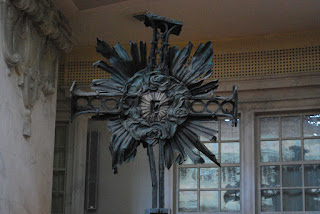.
note from July 23: I have several posts to make tonight, and to keep things chronological, I'm posting them in order, which will show up on the page as last one first
written July 21, but looking back
Dresden was always considered a jewel among cities in Germany. Dresden was famously destroyed by incendiary bombs dropped by the Allies in 1945. We have seen film footage taken from bombers the night of the raid, and we have heard stories about people swarming into the river, holding their babies above the water, to escape the firestorm. When our route between Saechische-Schweis and Berlin took us practically through Dresden, I wanted to stop for a couple of hours, to see how this jewel was faring.
The weather was back to sweltering, after a well-timed cloudy reprieve while we hiked the stone monoliths of Saechissche-Schweiss. Ezra got us to the centre of the old city, where we parked and had lunch to fortify ourselves, across from the Zwinger Palace. We dropped into the palace courtyard, but left promptly, as it was the architectural equivalent of strawberry mouse with double the sugar: too much for us. We wandered by orange plastic temporary fencing, rotating cranes, stacked concrete slabs, and megalithic holes in the ground; Dresden, like Berlin, is a city under construction. Beyond the containers and pneumatic drills, however, there was an old city full of character: long, yellow-painted row-houses with red-tiled roofs, narrow, twisting streets taking off higgledy-piggledy from an open market square as big as I’ve ever seen. The stunning centerpiece of the square is the Frauenkirche.
The Frauenkirche is a protestant church dedicated to the virgin Mary, an unusual circumstance in itself. It was built, originally, in the early 18th Century, and boasts the most significant stone dome north of the Alps. It’s a graceful building which seems taller than it is long, and with a footprint that seems to be practically circular, odd to an eye accustomed to the long and narrow shape of most stone churches.
The Frauenkirche was completely gutted by fire during the 1945 bombing raid, and her dome collapsed two days later. The ruins lay untouched in the city centre for 45 years. In the early 1990’s, a citizens' group sent out an appeal worldwide for the reconstruction of the church, and donations came in from more than 100,000 private donors. The Frauenkirche was rebuilt using the original plans and as much of the original material as could be salvaged. She was finally completed in 2005, a symbol of building bridges and reconciliation.
A man outside the church wanted to give me a pamphlet. I said, “No, danke”, not having mastered “nein” for spontaneous responses. He recognized that I spoke English and asked, in English, if I was Christian. I said no. He told me I had to accept Jesus into my life or I would be damned to hell. I told him I would take my chances. He said his life was nothing without Jesus and I told him I was happy he had found meaning for himself. He said he just knew I would burn in hell forever, and that he would pray for me to find Jesus before I died. I thanked him.
When I later told Katharina about the encounter, she was shocked; she had never heard of a German proselytizing like that.
When we entered the Frauenkirche, a choir was singing. This was an ad hoc concert by a visiting choir, who performed a single, gorgeous, polyphonic acappela song then left. We were so lucky to have caught them. John and Ezra sat in the pews, well into a deep discussion about religion and philosophy, while I wandered through the brightly painted interior, taking photos.
Inside the church is preserved the burnt ruin of the original cross that topped the dome, which had been buried in rubble for 45 years. Its replica tops the dome outside. People were lighting candles beside it.
I can’t help but be moved by these things.
I do not subscribe to any religion, and have a hard time imagining myself doing so, but nevertheless, I like churches. The old stone churches are enormous, with pillars that go up forever. The balance, the proportion, the colour from the stained glass that splashes on the floor below, and, man, the acoustics! It is all designed to inspire awe, and it works. It is designed to make us look up, and look up we do.
I like the idea of monuments built to some greater “other”. They seem to me to represent the relinquishing of self, and the belief that narcissism, with which we are plagued today, is not the way to a good and fulfilled life.
I know, I know, the Church has been an instrument of many evils, and the forced tithing of the poor to build cathedrals is among them. I can’t argue with that. However, I think we are arrogant if we believe we can see into the minds of medieval or Renaissance people and decide for them what might have been a better way to spend money. The buildings move me, and I suspect they have always moved anyone who enters.
A woman mounted the pulpit and began to speak; it was time for us to leave. We made our way back across the square and past the construction zone to the car, bound homeward, to Berlin.
.





1 comment:
I find it almost impossible to imagine the (I'm sure) overwhelming sense of age in a place like that. To see the pictures and read the details is one thing but to actually be there and have all five-plus senses recording it all... it's beyond me.
Still very envious! And hoping you're enjoying yourself.
Post a Comment